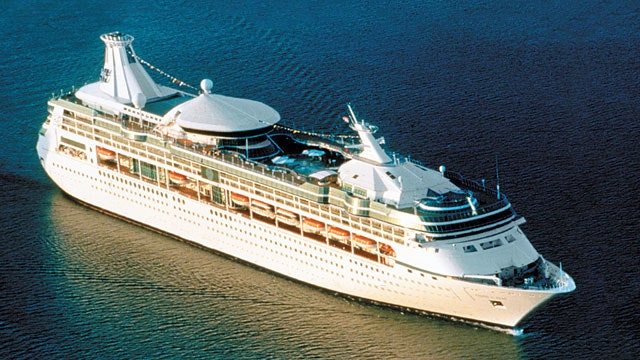If you’re at the pool with your kids on a cruise ship and think a professional lifeguard is watching them while you turn your back to share a quick Facebook post, think again. You’ve got to watch them every minute.
“Get in the water with them,” says B.J. Fisher, health and safety director of the American Lifeguard Association. The common wisdom: Be no more than an arm’s length away, particularly when you are with young children or novice swimmers.
Spring break is one of the most popular times for family cruising, and it’s not uncommon for megaships to have more than 1,000 kids on board. But despite the numerous aquatic features on many mega liners, there are no lifeguards on most ships. That's because there’s no industry standard for water safety on ships.
Each cruise line has its own water safety initiatives-- if it has any at all.
Since 2013, there have been 17 drownings or near drownings on cruise ships, according to Jim Walker, a Miami attorney who specializes in maritime law and oversees the website CruiseLawNews.com. At least 10 of these instances resulted in the death of a child under the age of 11, says Walker, and two resulted in serious brain injury that spurred legal action from the families involved.
The most recent occurred last summer, when an 8-year-old boy drowned on a Royal Caribbean ship as it left New York City for Bermuda.
THIS IS WHAT IT'S LIKE TO CRUISE ON THE WORLD'S LARGEST SUPERYACHT
Currently ,there is no industry wide standard for reporting or keeping track of these cases. If there is a death, Walker said, there is no requirement to notify the Coast Gard or local police. Most cruise lines are required to notify the flag state, often Panama or the Bahamas, where the ship is registered.
The Centers for Disease Control and Prevention’s data on drownings comes from death certificates and, in the cases of near-drownings, from emergency departments — not from a government agency’s incident reports, a CDC spokesman said. So the CDC has no way of knowing if a drowning or near-drowning occurred during vacation or on a cruise ship.
These incidents are exceedingly rare — more than a million kids cruise every year — but it’s easy to get distracted and lose sight of your child in a crowded pool or at the beach on a cruise line’s private island. And drowning is fast and silent.
About 10 people — including two children — drown on an average day, according to the CDC, and some of them know how to swim, according to the American Red Cross.
More than 600 children under 15 drowned in 2015, and for each one who died, five others were treated in emergency departments. Non-fatal injuries can cause long-term disabilities.
This month, Royal Caribbean International began what may be the largest cruise water safety program ever: a fleet-wide rollout that includes lifeguards and Coast Guard-approved life jackets for kids as well as voluntary water safety sessions as part of the regular programming for its Adventure Ocean kids and teen clubs. There still are no lifeguards at the cruise line’s private Caribbean island.
FOLLOW US ON FACEBOOK FOR MORE FOX LIFESTYLE NEWS
Attitudes about whether lifeguards are needed on cruise ships are starting to change, according to Cruise Critic. According to a poll on Cruise Critic’s home page, 34 percent of cruisers think ships should have lifeguards — a 10 percent increase over the past four years, says Colleen McDaniel, the website’s senior executive editor.
At the same time, cruise lines that cater to families with ever larger water slides and water play areas, including some for toddlers, have quietly been adding water safety initiatives. Besides Royal Caribbean:
— Norwegian Cruise Line stations crew members trained in water rescue and lifesaving procedures to monitor the family pools on its largest ships with Aqua Parks and water play areas. But they aren’t lifeguards, said Norwegian spokeswoman Vanessa Picariello. Norwegian has lifeguards at its private islands.
-- Carnival Cruise Line ships have Coast Guard-approved life jackets on board, but no lifeguards. Carnival’s sister brand, Holland America, has lifeguards on its private island, which Carnival uses.
-- Disney Cruise Line has had lifeguards and life jackets aboard its ships since 2013, and there are lifeguards at its private island. The action to introduce lifeguards came after a 4-year-old boy was left brain damaged and permanently disabled in May 2013 after a near-drowning aboard the Disney Fantasy.
But even if there are lifeguards, their job is to enforce rules and respond in an emergency — not to baby sit your kids, Fisher said. And don’t rely on blow-up “floaties” to keep them safe, the American Academy of Pediatrics warns.
A key component of the American Red Cross’ Circle of Drowning Prevention is to have adults designate a “watcher” who does nothing but monitor the kids in the water for a set amount of time. The “Circle” also includes teaching kids to swim, and it insists that inexperienced young swimmers should wear U.S. Coast Guard-approved life jackets. Older kids should always swim with a buddy, and parents should learn CPR, the experts say. In the time it takes for paramedics or trained rescuers to arrive, you could save a life.
Before you book you’re next cruise vacation, water safety experts advocate visiting redcross.org/takeaclass to find swim programs in your area, and download the free American Red Cross Swim App with kid-friendly games, videos and quizzes to learn about best practices for fun and safe pooltime play.
